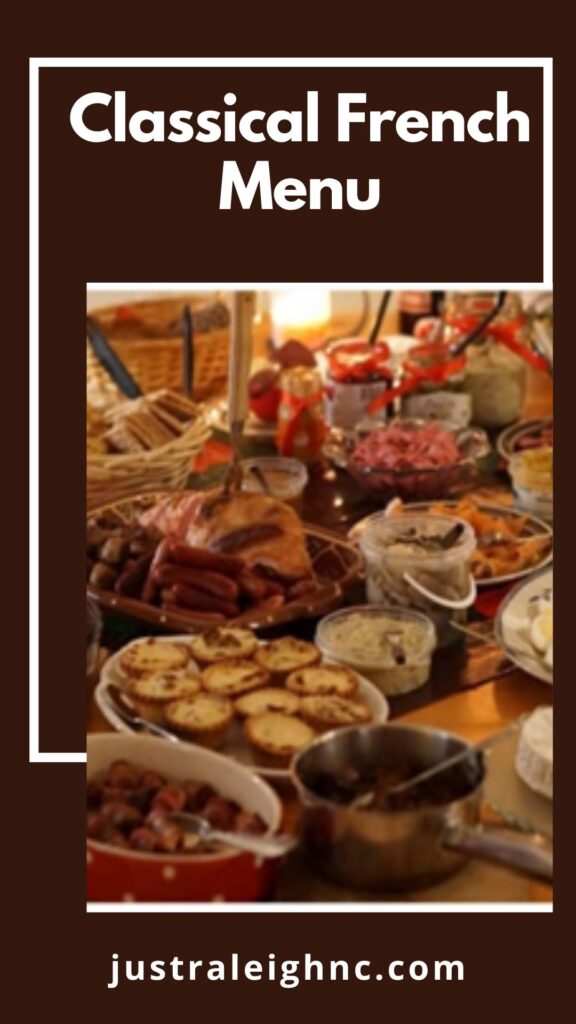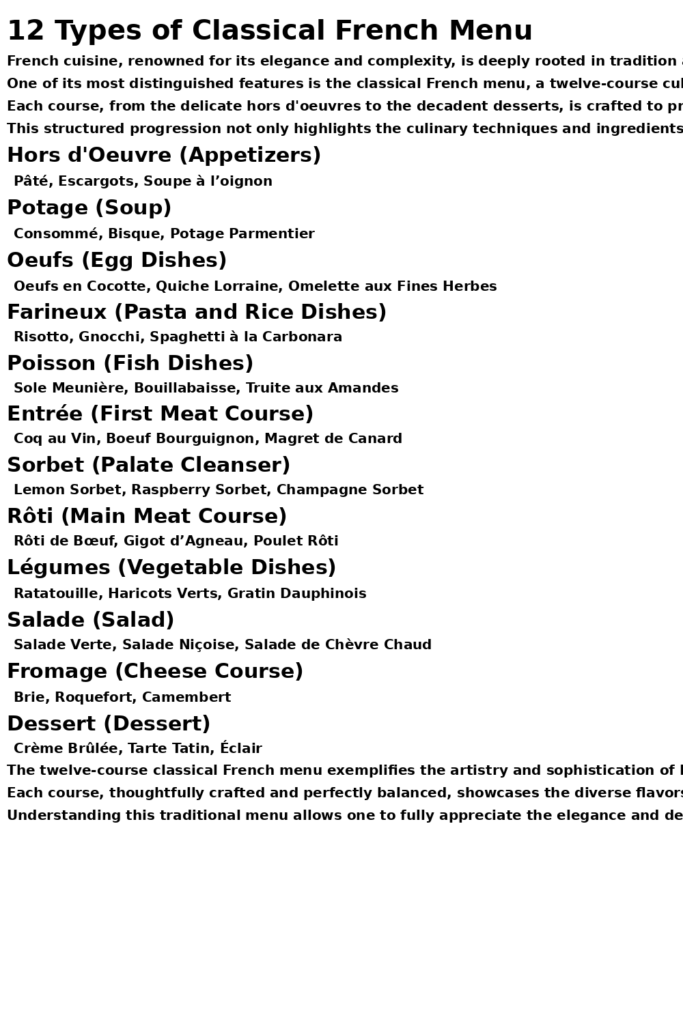French cuisine, renowned for its elegance and complexity, is deeply rooted in tradition and meticulous attention to detail. One of its most distinguished features is the classical French menu, a twelve-course culinary journey designed to tantalize the senses and showcase the rich diversity of French gastronomy.

Each course, from the delicate hors d’oeuvres to the decadent desserts, is crafted to provide a balanced and memorable dining experience. This structured progression not only highlights the culinary techniques and ingredients of France but also reflects the cultural importance placed on dining as an art form.
French cuisine, celebrated worldwide for its sophistication and depth of flavor, is built upon a foundation of tradition and artistry. One of the cornerstones of this culinary heritage is the classical French menu, a meticulously structured progression of dishes designed to take diners on a gastronomic journey.
Understanding these twelve types of classical French menus offers insight into the elegance and complexity of French dining. Here’s a detailed look at each type:
Hors d’Oeuvre (Appetizers)
Hors d’oeuvre are small, flavorful dishes served at the beginning of a meal. They are designed to stimulate the appetite without being too filling. Examples include:
- Pâté: A rich spread made from finely ground meat and fat.
- Escargots: Snails cooked in garlic butter.
- Soupe à l’oignon: French onion soup, often topped with melted cheese.
Potage (Soup)
Potage is the soup course, offering a warm, comforting start to the meal. French soups are diverse, ranging from clear broths to thick, creamy concoctions. Notable examples are:
- Consommé: A clear, flavorful broth.
- Bisque: A rich, creamy soup made from crustaceans like lobster or shrimp.
- Potage Parmentier: A creamy leek and potato soup.
Oeufs (Egg Dishes)
This course features various egg preparations, showcasing the versatility of eggs in French cuisine. Examples include:
- Oeufs en Cocotte: Eggs baked in a ramekin with cream and other ingredients.
- Quiche Lorraine: A savory tart with a filling of eggs, cream, and bacon.
- Omelette aux Fines Herbes: A simple omelette with fresh herbs.
Farineux (Pasta and Rice Dishes)
Farineux encompasses dishes made from grains such as pasta and rice. These dishes often serve as a bridge between lighter and heavier courses. Examples are:
- Risotto: A creamy rice dish cooked with broth and flavored with various ingredients.
- Gnocchi: Small, soft dough dumplings made from potatoes or flour.
- Spaghetti à la Carbonara: Pasta with a sauce made from eggs, cheese, pancetta, and pepper.
Poisson (Fish Dishes)
Poisson includes a variety of fish preparations, highlighting the bounty of the sea. French fish dishes are known for their delicate flavors and elegant presentation. Examples include:
- Sole Meunière: Sole fillets cooked in butter and lemon.
- Bouillabaisse: A traditional Provençal fish stew.
- Truite aux Amandes: Trout with almonds.
Entrée (First Meat Course)
The entrée is the first substantial meat course, featuring a variety of meats prepared in numerous ways. Examples are:
- Coq au Vin: Chicken braised in red wine with mushrooms and onions.
- Boeuf Bourguignon: Beef stewed with red wine, mushrooms, and onions.
- Magret de Canard: Duck breast, often served with a fruit sauce.
Sorbet (Palate Cleanser)
A small serving of sorbet is served to cleanse the palate and prepare diners for the next course. It is typically light and refreshing, with flavors such as:
- Lemon Sorbet: Tart and refreshing.
- Raspberry Sorbet: Sweet and tangy.
- Champagne Sorbet: Light and effervescent.
Rôti (Main Meat Course)
The rôti course is the main meat dish, often featuring roasted meats served with rich sauces and accompaniments. Examples include:
- Rôti de Bœuf: Roast beef.
- Gigot d’Agneau: Roast leg of lamb.
- Poulet Rôti: Roast chicken.
Légumes (Vegetable Dishes)
Légumes are vegetable dishes served as side dishes or as standalone courses. French vegetable preparations emphasize fresh, seasonal produce. Examples are:
- Ratatouille: A stewed vegetable dish with eggplant, zucchini, peppers, and tomatoes.
- Haricots Verts: French green beans, often served with butter and garlic.
- Gratin Dauphinois: Potatoes baked in cream and cheese.
Salade (Salad)
The salad course is a light, refreshing dish that helps balance the meal. It is typically served after the main course to aid digestion. Examples include:
- Salade Verte: A simple green salad with vinaigrette.
- Salade Niçoise: A composed salad with tuna, olives, eggs, and vegetables.
- Salade de Chèvre Chaud: Salad with warm goat cheese.
Fromage (Cheese Course)
The cheese course is a quintessential part of a French meal, offering a variety of cheeses to savor. A well-curated cheese platter may include:
- Brie: A soft, creamy cheese.
- Roquefort: A tangy blue cheese.
- Camembert: A soft, buttery cheese.
Dessert (Dessert)
The dessert course concludes the meal with a sweet treat. French desserts are renowned for their elegance and flavor. Examples include:
Crème Brûlée: A creamy custard with a caramelized sugar crust.
Tarte Tatin: An upside-down apple tart.
Éclair: A pastry filled with cream and topped with chocolate icing.

Final Thoughts on Classical French Menu
The twelve-course classical French menu exemplifies the artistry and sophistication of French cuisine, offering a meticulously curated dining experience that celebrates the country’s rich culinary heritage.
Each course, thoughtfully crafted and perfectly balanced, showcases the diverse flavors and techniques that define French gastronomy.
Understanding this traditional menu allows one to fully appreciate the elegance and depth of French culinary traditions, transforming a meal into a memorable gastronomic journey.





